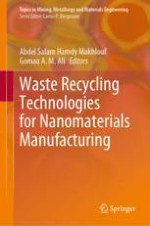2021 | OriginalPaper | Chapter
Bottom-Up Approach Through Microbial Green Biosynthesis of Nanoparticles from Waste
Author : Rania Azouz
Published in: Waste Recycling Technologies for Nanomaterials Manufacturing
Publisher: Springer International Publishing
Activate our intelligent search to find suitable subject content or patents.
Select sections of text to find matching patents with Artificial Intelligence. powered by
Select sections of text to find additional relevant content using AI-assisted search. powered by
